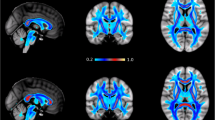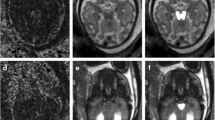Abstract
Background
Diffusion tensor imaging and tractography have been used to evaluate a variety of brain malformations. However, these studies have focused mainly on malformations involving the supratentorial compartments. There is a paucity of data on diffusion tensor imaging of posterior fossa malformations.
Objective
To describe the color vector maps and modified or abnormal tracts of midline posterior fossa malformations.
Materials and Methods
Diffusion tensor imaging was performed in one patient with rhombencephalosynapsis and two with Joubert syndrome. Color vector maps of fractional anisotropy were used to place a region of interest for seed point of fiber tracking.
Results
The vermis was severely hypoplastic or absent in rhombencephalosynapsis and Joubert syndrome. In rhombencephalosynapsis, vertically oriented fibers were visualized in the midportion of the cerebellum. The location of the deep cerebellar nuclei could be inferred from the amiculum and were medially located in rhombencephalosynapsis. In the two patients with Joubert syndrome, the horizontally arranged superior cerebellar peduncles were well demonstrated on the color vector maps. Failure of the superior cerebellar peduncles to decussate in the mesencephalon was also well demonstrated on both color vector maps and tractography. The deep cerebellar nuclei were more laterally located in Joubert syndrome.
Conclusion
The use of tractography in midline posterior fossa malformations expands our understanding of these malformations.




Similar content being viewed by others
References
Guye M, Parker GJ, Symms M, et al (2003) Combined functional MRI and tractography to demonstrate the connectivity of the human primary motor cortex in vivo. Neuroimage 19:1349–1360
Nimsky C, Ganslandt O, Hastreiter P, et al (2005) Preoperative and intraoperative diffusion tensor imaging-based fiber tracking in glioma surgery. Neurosurgery 56:130–137; discussion 138
Yu CS, Li KC, Xuan Y, et al (2005) Diffusion tensor tractography in patients with cerebral tumors: a helpful technique for neurosurgical planning and postoperative assessment. Eur J Radiol 56:197–204
Albayram S, Melhem ER, Mori S, et al (2002) Holoprosencephaly in children: diffusion tensor MR imaging of white matter tracts of the brainstem – initial experience. Radiology 223:645–651
Eriksson SH, Symms MR, Rugg-Gunn FJ, et al (2002) Exploring white matter tracts in band heterotopia using diffusion tractography. Ann Neurol 52:327–334
Lee SK, Kim DI, Mori S, et al (2004) Diffusion tensor MRI visualizes decreased subcortical fiber connectivity in focal cortical dysplasia. Neuroimage 22:1826–1829
Lim CC, Yin H, Loh NK, et al (2005) Malformations of cortical development: high-resolution MR and diffusion tensor imaging of fiber tracts at 3T. AJNR 26:61–64
Jones DK, Horsfield MA, Simmons A (1999) Optimal strategies for measuring diffusion in anisotropic systems by magnetic resonance imaging. Magn Reson Med 42:515–525
Pajevic S, Pierpaoli C (1999) Color schemes to represent the orientation of anisotropic tissues from diffusion tensor data: application to white matter fiber tract mapping in the human brain. Magn Reson Med 42:526–540
Montull C, Mercader JM, Peri J, et al (2000) Neuroradiological and clinical findings in rhombencephalosynapsis. Neuroradiology 42:272–274
Simmons G, Damiano TR, Truwit CL (1993) MRI and clinical findings in rhombencephalosynapsis. J Comput Assist Tomogr 17:211–214
Solomon R, Jana AK, Singh S, et al (2001) Joubert syndrome. Indian Pediatr 38:1045–1049
Truwit CL, Barkovich AJ, Shanahan R, et al (1991) MR imaging of rhombencephalosynapsis: report of three cases and review of the literature. AJNR 12:957–965
Joubert M, Eisenring JJ, Andermann F (1968) Familial dysgenesis of the vermis: a syndrome of hyperventilation, abnormal eye movements and retardation. Neurology 18:302–303
Joubert M, Eisenring JJ, Robb JP, et al (1969) Familial agenesis of the cerebellar vermis. A syndrome of episodic hyperpnea, abnormal eye movements, ataxia, and retardation. Neurology 19:813–825
Parent A (1996) Carpenter’s human neuroanatomy, 9th edn. Williams & Wilkins, Philadelphia
Utsunomiya H, Takano K, Ogasawara T, et al (1998) Rhombencephalosynapsis: cerebellar embryogenesis. AJNR 19:547–549
Ferland RJ, Eyaid W, Collura RV, et al (2004) Abnormal cerebellar development and axonal decussation due to mutations in AHI1 in Joubert syndrome. Nat Genet 36:1008–1013
Heuyer G, Feld M, Gruner J (1959) Malformations Congénitales du Cerveau. Colloque International sur les Malformations Congénitales de l'Encéphale. Masson,Paris
Lee SK, Kim DI, Kim J, et al (2005) Diffusion-tensor MR imaging and fiber tractography: a new method of describing aberrant fiber connections in developmental CNS anomalies. Radiographics 25:53–65; discussion 66–68
Yachnis AT, Rorke LB (1999) Neuropathology of Joubert syndrome. J Child Neurol 14:655–659; discussion 669–672
Author information
Authors and Affiliations
Corresponding author
Rights and permissions
About this article
Cite this article
Widjaja, E., Blaser, S. & Raybaud, C. Diffusion tensor imaging of midline posterior fossa malformations. Pediatr Radiol 36, 510–517 (2006). https://doi.org/10.1007/s00247-006-0146-x
Received:
Revised:
Accepted:
Published:
Issue Date:
DOI: https://doi.org/10.1007/s00247-006-0146-x




